Quality filtration is vital when it comes to keeping a healthy aquarium. Having a good water filter is like a breath of fresh air for your aquatic buddies, so you’ll want the best canister filter for the job.
To help you decide, I purchased 7 canister filters at different price points and ran them on my own tanks for serval weeks.
In this review, I’ll show you how I tested them, what I liked and didn’t like, as well as which canister filter is best for different kinds of aquarium setups.
Review Overview
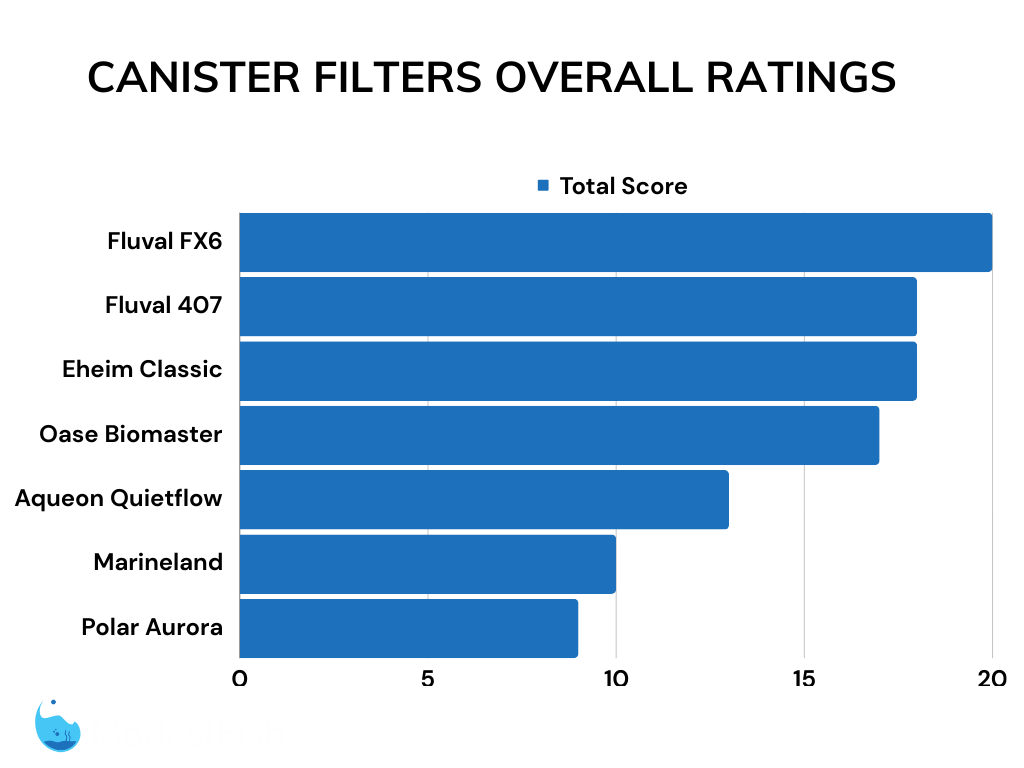
After testing seven different canister filters in my various home aquariums, I assigned them rankings based on their overall performance.
I was most impressed by the Fluval filters that I tried out. I tested two different canisters from the German manufacturer, the FX6 and the 407, and both of these filters were quiet, efficient and I loved all of the features.
However, it should be noted that the Eheim Classic canister made a surprisingly strong showing, despite the fact it is a much simpler design than the tricked out Fluval filters. If you like old school simplicity, this is the one for you.
The Aqueon Quietflow was the standout from the economy filters. It has the best balance of lower price versus features.
And the Oase Biomaster made a good showing. It has unique features, like a built-in heater and a sturdy handle on the motorhead that make it stand out.
| Preview | Product | |
|---|---|---|

|
Fluval FX6 High Performance Aquarium Filter, Canister Filter for Aquariums up to 400 Gal. | Buy on Amazon |

|
Fluval 407 Perfomance Canister Filter - for Aquariums Up to 100 Gallons - Aquarium Canister Filter | Buy on Amazon |

|
EHEIM Classic 2215 External Canister Filter with Media for up to 92 US Gallons | Buy on Amazon |

|
OASE Indoor Aquatics Biomaster Thermo 250,Black | Buy on Amazon |

|
Aqueon QuietFlow Canister Filter 200 GPH, For Up to 55 Gallon Aquariums | Buy on Amazon |

|
Marineland Magniflow Canister Filter For aquariums, Easy Maintenance,Black | Buy on Amazon |

|
Polar Aurora Free Media 265GPH / 370GPH / 525GPH External Aquarium Filter with Builtin Pump Kit... | Buy on Amazon |
Last update on 2024-04-18 / Commissions Earned / Images from Amazon Product Advertising API
Who Are Canister Filters Right For?
Maybe? Or maybe not.
Whether or not you need a canister filter really depends on the individual circumstances of your aquarium.
If you have a 20 gallon (76 liter) tank with a few guppies in it, a canister filter is total overkill and you’d probably be better off with a hang-on-the-back or sponge filter.
But, if you plan on running a 55 gallon (208 liter) tank, heavily stocked with African cichlids, a canister filter is probably a great fit.
Canister filters pump out a lot of water and hold an enormous amount of biomedia, the special kind of filter media that houses beneficial bacteria.
So, they’re best suited to larger aquariums with a lot of fish.
The Canister Filters I Bought & Tested
- Fluval FX6
- Fluval 407
- Eheim Classic
- Oase Biomaster Thermo 250
- Aqueon Quietflow
- Marineland Magniflow
- Polar Aurora
How I Tested The Canister Filters
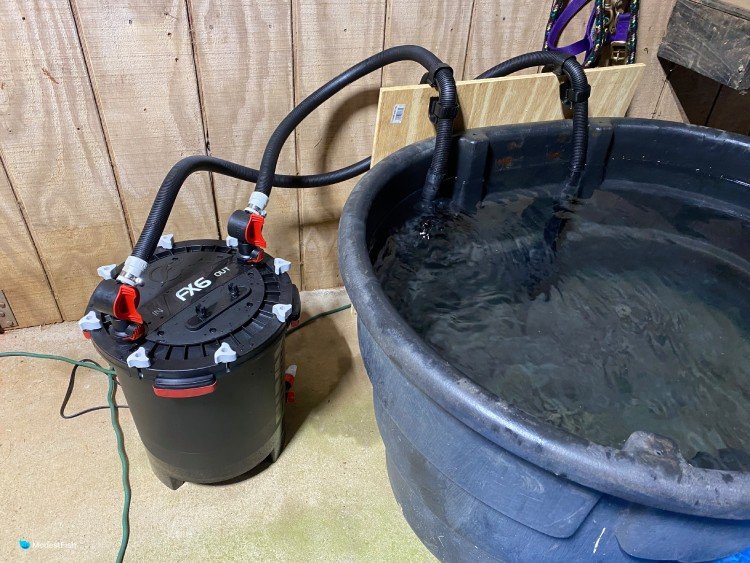
GPH Testing & Why it is Important
GPH stands for gallons per hour. It’s a measure of how much water a filter pumps each hour.
The bigger the filter motor, the higher its GPH will be.
GPH is an important consideration. In order to keep things filtered properly, the pump has to pass enough water over the filter media every hour for the bacteria to eat all the waste that’s floating around.
If there’s too little flow, the bacteria can’t process enough waste to keep the tank water healthy.
You usually want your filter to have enough GPH to turnover the volume of your tank about 4 times per hour. So, for example, you’d want a GPH of at least 200 for a 50 gallon (190 liter) aquarium.
GPH Testing Procedure
I wanted to measure the GPH of each of these canister filters because actual GPH can be very different from the GPH rating on the box.
I found some substantial differences when I tested hang-on-the-back filters last year.
To test the GPH, I set up each filter with its included media. Filters can be slowed down when their media is full of gunk, so I made sure to test each one with nice clean media to make things as fair as possible.
I set up a clear plastic storage tote on top of a plastic barrel and filled it with water.
The filters were then set up to run using the water from the tote. Once a filter was primed, I allowed it to run for about 10 minutes or so to make sure it had belched any air out of its system and was running smoothly.
I then diverted the outflow into a 2 gallon (7.5 liter) container. I timed how long it took for the container to fill with water. Just to make sure, I did this three times for each filter, and then used the average of those numbers for my calculations.
Yay! Time for math… is a sentence you will never hear me say. But hopefully, I did pretty well here.
I took the average of the testing times and then divided them by 2. That gave me the gallons per second.
Then, I took that number and divided it into 3600, the number of seconds in an hour to figure out the GPH.
Here’s an example, if the times were 30.7, 31.2 and 30.5.
The average of those times would be 30.8 seconds.
30.8 ÷ 2 = 15.4
3600 ÷ 15.4 = 233.77 GPH
GPH Results
The chart below shows the GPH ratings that are listed by each manufacturer compared with the numbers that I got during testing. Just like with the hang-on-the-back filter testing I did, the actual GPH of each filter turned out to be much lower than the rating listed on the box.
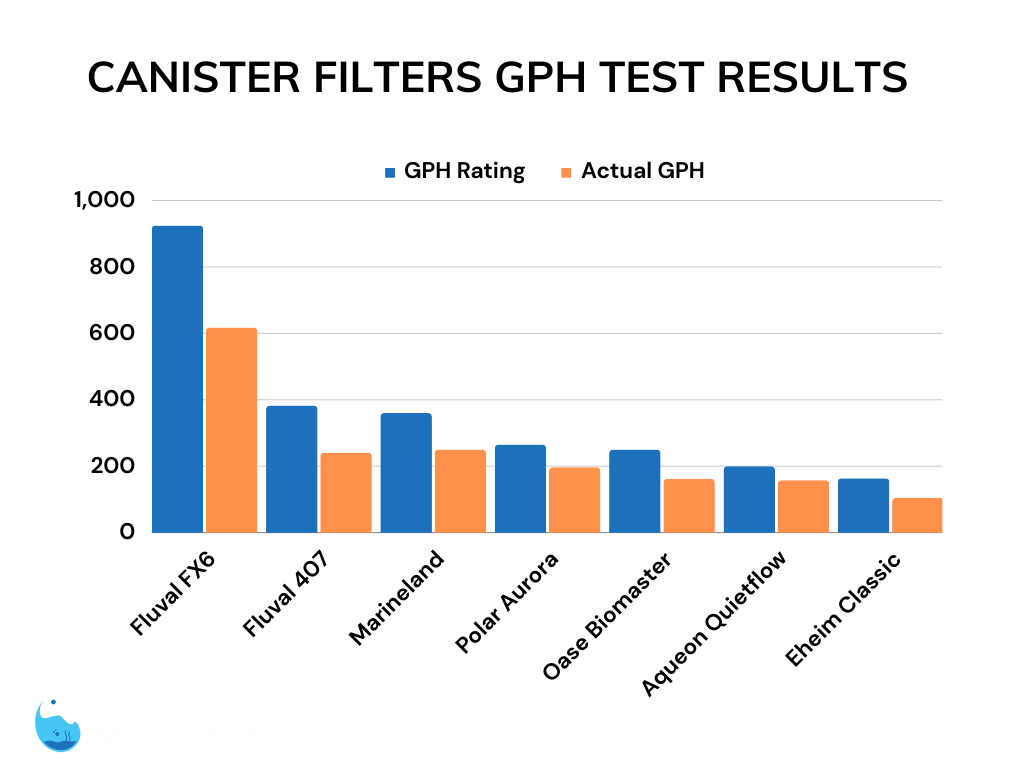
GPH ratings are based on what the motor can pump out by itself, in perfect lab conditions, with no canister body or filter media.
The GPH immediately goes down as soon as you start adding on obstacles like hoses and filter media.
GPH really goes down when the filter media gets dirty and clogged with algae and fish waste. Regular filter maintenance to clear out gunk is very important to keep your system running properly.
How Ratings Were Assigned
Each filter was given a score from 1-5 (1 being the worst and 5 being the best) for the following categories:
- Installation
- Priming
- Maintenance
Then, I gave each filter a rank from 1-6, 1 being the loudest and 6 being the quietest, for noise levels. These points were then added to the previous scores.
I tabulated all of this data to create the overall rankings.
Noise Level Testing
I measured the noise each filter emitted with a handheld decibel meter multiple times and took the average.
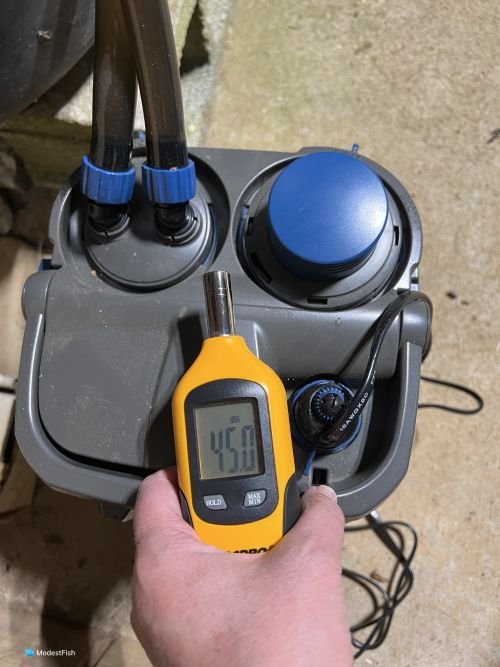
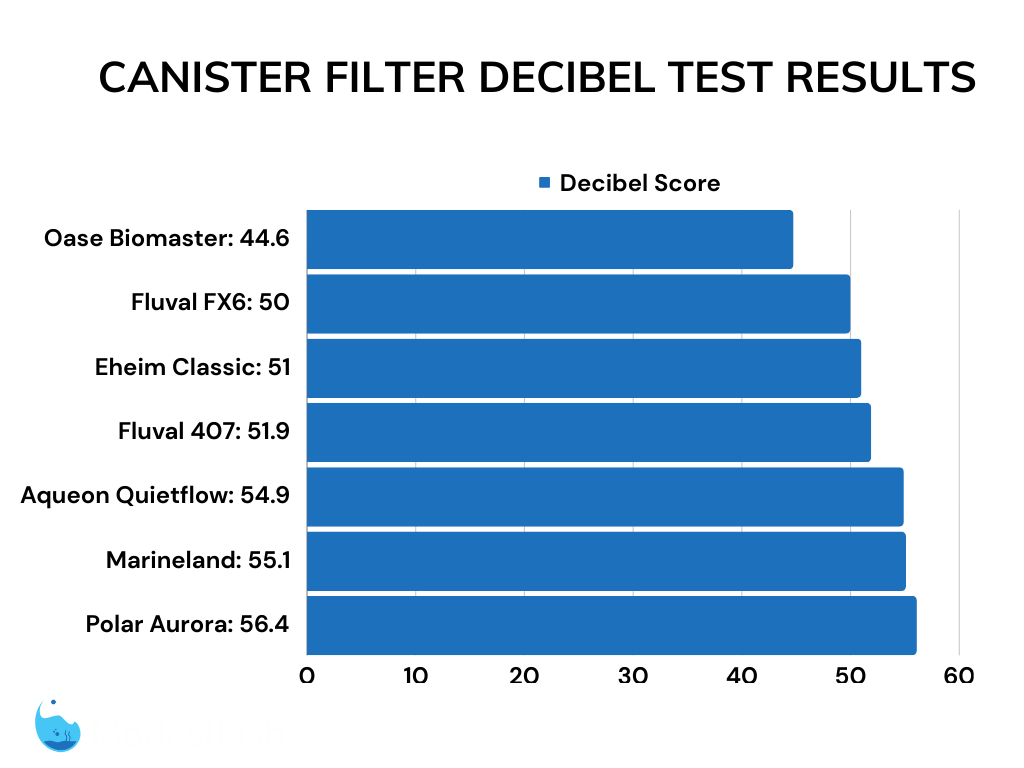
Best Canister Filter Reviews
1. Fluval FX6
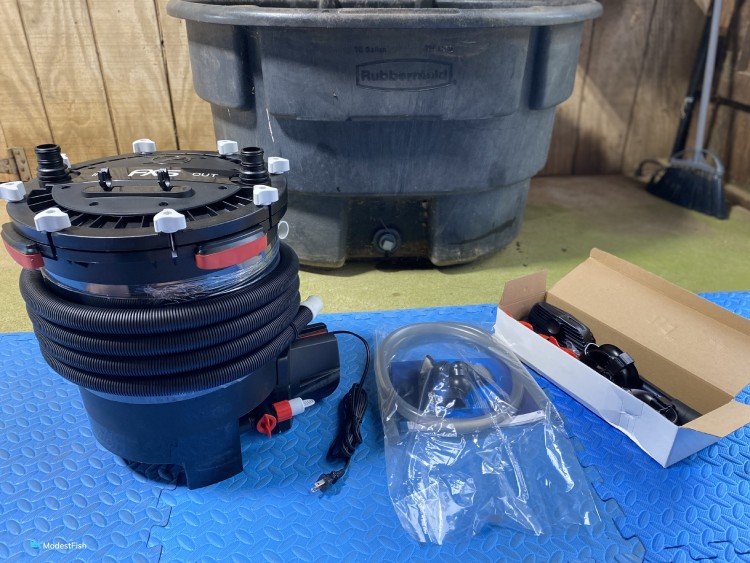
GPH: 617.5
Installation: getting this filter installed is a little challenging.
The hoses are clunky and temperamental when you’re trying to get them set up. They’re a bit rigid and fairly difficult to bend. You have to curl them around these curved holders that fit them over the rim of the tank.
The hoses have to be curved around the bottom of the holder and then a top piece is snapped on to keep it all in place. This is easier said than done.
I recommend getting someone to help you with this part so one person can keep everything in place and the other can snap the pieces of the holder together.
You get a very large, very detailed instruction manual with this filter. I highly recommend pulling this out and reading the whole thing before you begin.
Don’t groan at me! There’s a lot to this filter and knowing what each step is ahead of time is very helpful.
Priming: priming this filter is very simple. You should fill the canister with tank water before sealing the lid.
Then, you just plug it in and it should start up. If the filter shuts off shortly after you plug it in, don’t worry. This filter shuts itself off periodically to purge air out of the system. Just give it a few minutes, and it will start up again.
Maintenance: maintenance is so simple on this filter. Central handles let you pull out all the filter media at once from the top. I really love this.
There is also a nifty drain at the bottom of the canister that you can attach tubing to that you can run into a bucket. Gravity pushes the water out of the drain, so you don’t have to try to carry the full canister.
Noise: this was the quietest of all the canister filters I tried, despite the fact that it pumps the most water. This filter emitted only 50 decibels, which was over 4 times quieter than the loudest canister I tested.
In a quiet room, you’ll hear a soft hum from this filter. If you have it installed under a tank stand, you likely wouldn’t hear it at all.
Best for: large aquarium setups between 100-200 gallons (379-757 liters).
I know that Fluval rates this filter for up to 400 gallon (1514 liter) aquariums, but I don’t think it has enough flow for a tank that big.
I would actually recommend two of these filters for an aquarium of that size.
Pros:
- Immense biomedia capacity
- Strong but quiet pump
- Simple maintenance
Cons:
- Hoses are a pain to install
- Canister has a large footprint
- No spray bar included

Last update on 2024-04-18 / Commissions Earned / Images from Amazon Product Advertising API
You can read my full in-depth review of the Fluval FX6 Canister Filter here.
2. Fluval 407
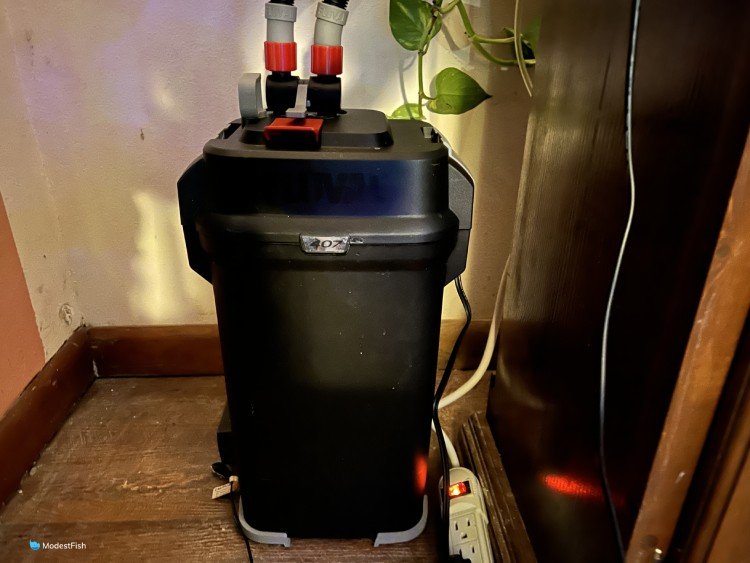
GPH: 240.64
Installation: just like the FX6, my only real complaint with this filter has to do with installation.
It’s a bit less complicated to get one of these filters set up, but I still HIGHLY recommend reading the instruction manual beforehand.
This filter has hoses and holders that are similar to the FX6’s. They are a little bit easier because the hoses are a smaller gauge, but getting them installed is still a bit of a headache.
Also, the installation instructions were missing critical information about how to open the water flow on the quick connect valve, which was a hassle.
I love, love, love that this filter comes with such great reusable mechanical media. I wish all filters came with these sponges. They’re really big and catch tons of gunk out of the water.
Priming: getting this filter primed is very simple.
There is a small priming lever that you plunge up and down a few times that will start flooding the canister with water.
You just wait for the gurgling to stop and plug the canister in. Everything should start right up after that.
Maintenance: I love how simple it is to do maintenance on this filter!
The quick connect valves make it simple to stop the water flow and pop the hoses free of the motorhead.
There is a central handle that lets you pull out all the media baskets from the top, awesome feature.
It’s easy to break the filter down beside the tank. I put the media into a bucket, so I could carry the canister and dump out the nasty filter water.
Noise: this is the third quietest canister filter that we tested, emitting only 51.9 decibels. It puts off only a low hum, I’ve been very impressed.
Best for: 40-55 gallon (151-208 liter) tanks. I’m personally running this on a well planted 55 gallon I use for angelfish.
I know Fluval has this rated as up to 100 gallons (379 liters), but I think that volume would be too much for this filter.
Pros:
- Very quiet
- Simple maintenance
- Great mechanical media
Cons:
- Getting hoses installed was a pain
- No spray bar included

Last update on 2024-04-17 / Commissions Earned / Images from Amazon Product Advertising API
You can read my full in-depth review of the Fluval 407 canister filter here.
3. Eheim Classic
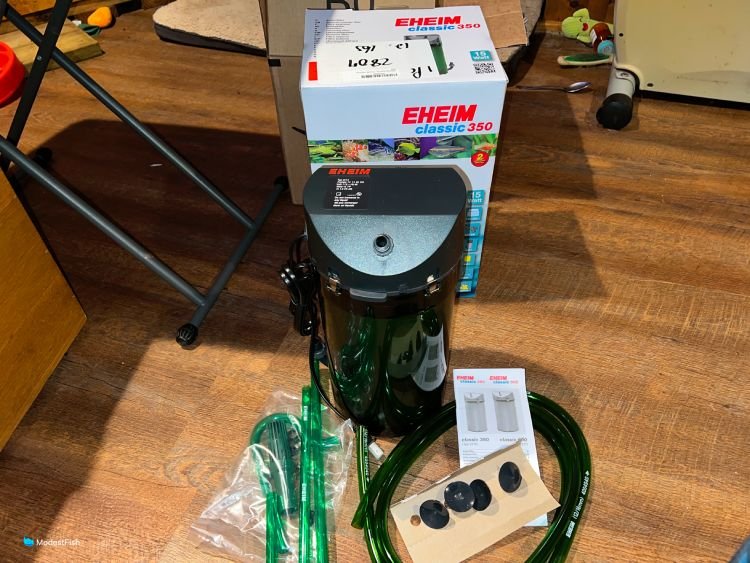
GPH: 105.11
Installation: getting this filter installed is incredibly simple.
This Eheim Classic is just a large, open canister filled with loose filter media.
Installation mostly just consists of rinsing all the media off and then layering it inside the canister.
I loved how easy it was to get the hoses, intake and outflow set up.
The hoses are very pliable and don’t fight you. The quick connect valves are plumbed inline on the hoses and only took me a few minutes to add on.
Both the intake and outflow tubes are curved to easily go over the side of the tank. These were the simplest to set up out of the bunch.
The only drawback to this filter is that it doesn’t come with much mechanical filter media. But, since the canister is just a cylinder, it’s not hard to cut some matten filter media to fit inside.
Priming: this filter has a unique priming method.
You detach the hose from the quick connect on the intake and suck a little air through it with your mouth. This will start water flowing into the canister.
You just reattach the intake hose and let the canister fill with water. Then you plug in the filter and it should start drawing water from the tank.
Maintenance: just like installation, the no frills design of this filter makes maintenance super simple.
I thought that doing maintenance on this filter was going to be difficult because there are no media baskets.
But, I was pleasantly surprised to find the exact opposite was true.
Since the intake hose comes from the bottom of the canister, you can use this to easily drain the water out. Then you can just pour the loose media into buckets and rinse out the sponges, so simple!
Noise: this Eheim is the second quietest filter that I tested. I measured an average 51.0 decibels from this filter.
It makes a quiet hum that’s barely noticeable.
Best for: this Eheim Classic is best suited for 30-40 gallon (113-151 liter) tanks.
I initially thought this would be good for up to 55 gallon (208 liter) tanks, but the actual GPH numbers were a little too low for a tank that big.
I’ve had this filter running on my 40 gallon planted rainbow fish tank and I have been really happy with it.
Pros:
- Simple, straightforward setup and priming
- Easy maintenance
- Quiet operation
Cons:
- Very limited mechanical media included

Last update on 2024-04-17 / Commissions Earned / Images from Amazon Product Advertising API
You can read my full in-depth review of the Eheim Classic Canister filter here.
4. Oase Biomaster Thermo 250
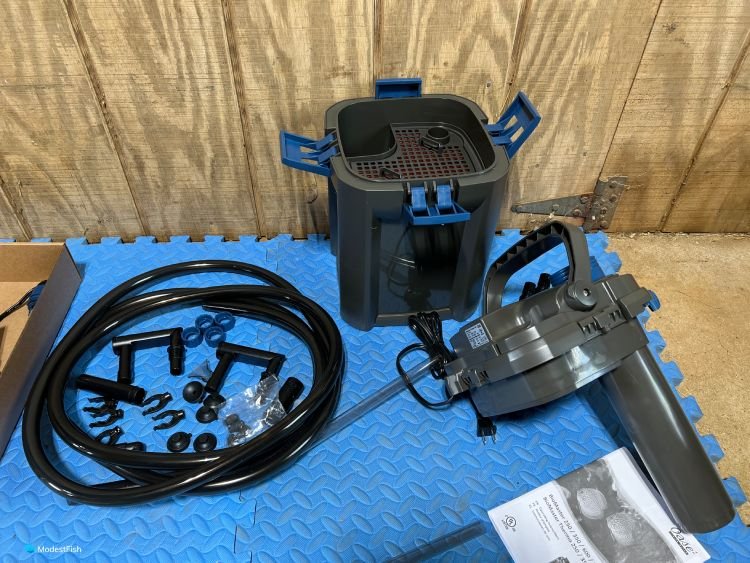
GPH: 162.24
Installation: this Oase canister has a unique pre-filter. It’s basically a plastic tube that houses a stack of small, black sponges, similar to the ones used as pre-filters on hang-on-the-back filters.
These are meant to filter out detritus and algae before it enters the main canister body. This is great, but these fine sponges can get really clogged up, so make sure to clean these out regularly.
It also has a built-in heater, a feature none of the other canisters have. It’s a glass 200 watt heater that attaches to the underside of the motorhead.
The pre-filter and the built-in heater do make it a little more complicated to get this filter installed, but I think they’re well worth the effort.
The main canister body has four stacking media baskets. Three are dedicated to reusable sponge and the fourth is filled with a plastic biomedia that’s kind of like a cross between bio balls and ceramic noodles.
Normally, I complain that filters don’t have enough mechanical media, but I actually think that this one has a little too much. If I was going to run this filter long term, I would probably take out one of the sponges and replace it with more biomedia.
Priming: I had a little trouble getting this filter primed the first time, but I don’t know for sure that it wasn’t just an operator problem.
Once I had everything set up, I pushed the priming button on top of the motorhead for about a minute, but nothing happened.
I then took the motorhead back off, fiddled with it a little bit, and then put it back in place. That time, as soon as I pushed the button, water started to flow into the canister.
The problem could have been that I didn’t have the motorhead seated correctly the first time or it could be this filter might be more finicky than most. Since I did have an issue, I thought I should mention it.
The hoses hold onto the siphon for you while you’re doing maintenance, so priming after cleaning was very simple. I just reattached the hoses, unlocked them and water started flowing into the canister, super easy.
Maintenance: cleaning this filter out is fairly simple, but you do need to be mindful about the heater.
The motorhead has a big, flip-up handle on the top that makes it so much easier to carry this filter where you need it for draining. It can be very hard to get a solid grip on a canister filter when you need to lug it around.
I so wish that every canister filter had a handle like this one!!
I especially like that it adds stability when you’re removing the motorhead. Both the built-in heater and the pre-filter hang down from the underside of the motorhead, so it’s nice to have a solid way to grip the lid when you’re pulling things apart.
It was very easy to break down the canister and rinse out the sponges in dechlorinated water to get rid of the built up gunk. Because there is so much mechanical media, the biomedia did not have much on it at all, just a little bit of algae.
But, I do have to knock some points off on maintenance because you have to be very cautious when you break this filter down.
Make sure to unplug the heater and let it sit for at least 15 minutes before removing the motorhead. This ensures that the heater has time to cool down. Removing the heater from the water while it’s still hot could cause it to crack.
With other canisters, you can just unplug the filter and tear it right apart if you want. But, it’s really not safe to do that with this Oase Biomaster. You should wait and make absolutely sure that the built-in heater has cooled down.
Noise: I got an average reading of 44.76 decibels when I tested this filter. That makes this the quietest of all the filters that I’ve tested.
The next quietest filter, the Fluval FX6, is over 3 times louder than this Oase.
If you listen very, very closely, you can hear a slight hum coming from this canister. It really is not noticeable unless you put your ear right next to the filter.
Temperature control: I was really impressed by how well the built-in heater was able to maintain the temperature in the tank.
When I was testing this filter, I was using my 70 gallon (265 liter) horse trough as a grow out tank for a school of angelfish that I bred. Angels need really warm water, so I set the heater to 80°F (27°F).
The trough is out in my barn, so I was concerned that the heater wouldn’t be able to compensate for large temperature dips, but I was pleasantly surprised. The temp in the tank stayed at 80°F throughout the testing period, even when the temperature in the barn dropped down into the high 60s.
Best for: this Oase filter is best suited for 40-50 gallon (151-208 liter) tanks.
I would especially recommend this for tropical nano fish tanks. The built-in heater is much safer for tiny fish and can prevent burns.
I have lost several fish to heater burns. Some fish will try to dart behind the heater when they’re frightened. All it takes is a split second of contact with the heating surface to cause fatal injuries.
This filter is also a great choice for anyone who is trying to minimize the appearance of equipment inside their main display tank. You don’t have to look at a heater stuck to the back of the tank since it’s tucked away inside the canister.
I do not recommend this filter for cold water fish, like goldfish. Fish like these do not need a heater, so spending the extra for a filter with a built-in heater is a bit of a waste.
Pros:
- Quietest filter tested
- Built-in heater
- Lots of mechanical filter media
- Sturdy motorhead handle
Cons:
- Not as much room for biomedia
- Maintenance is a little more complicated

Last update on 2024-04-17 / Commissions Earned / Images from Amazon Product Advertising API
You can read my full in-depth review of the Oase Biomaster Filter here.
5. Aqueon Quietflow
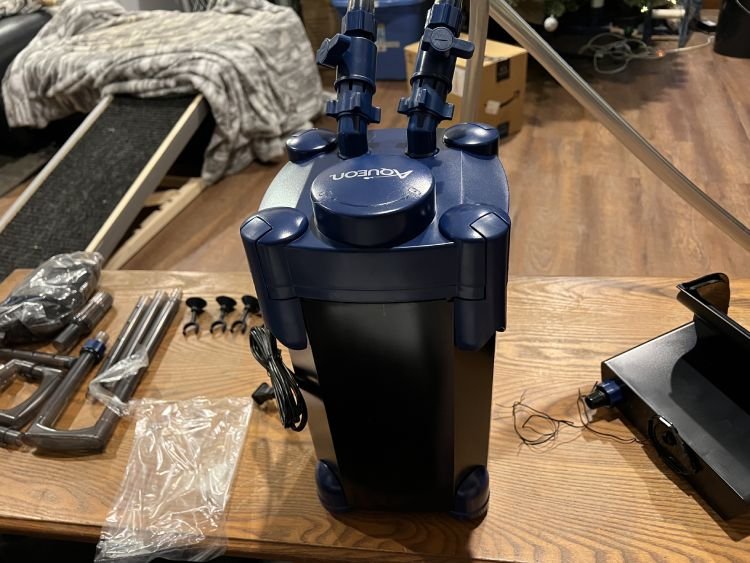
GPH: 157.96
Installation: you have a lot of options when it comes to installing this filter.
This Aqueon Quietflow comes with three different outflow attachments:
- Directional nozzle
- Spray bar
- Water polishing unit
The directional nozzle and spray bar are typical of what comes with most canister filters, but the water polishing unit is unique to the Quietflow.
It’s similar to a traditional hang-on-the-back filter. It sits on the rim of the tank and the outflow hose attaches to the bottom of it.
As water flows back from the canister to the tank, it’s passed through a filter cartridge that is made up of an ultra fine polishing pad and some carbon attached to a plastic frame.
I’m not a huge fan of this unit. It’s a big hulking thing on the back of the tank. One of the perks of a canister is the ability to limit the visibility of the filter. This attachment completely negates that.
Also, I don’t like being roped into buying expensive filter cartridges. I would much rather add on more reusable sponges and skip this thing. I prefer the spray bar.
I had an easy time getting this canister set up. It utilizes the typical stacking media baskets.
The hoses were very cooperative. I placed this canister inside the stand of one of my 40 gallon bowfront aquariums. It was easy to route the hoses through the back of the stand and up to the back of the tank.
Priming: getting this filter primed is fairly straightforward, but kind of a pain in the butt.
On the top of the motorhead is a large plastic cap that you twist off. This exposes a hole in the top of the filter that you use to pour water into to fill the canister.
Aqueon calls this thing a “funnel”, but I would have to wholeheartedly disagree. This thing is vaguely shaped like a funnel, but the sides are so low that you would have to just barely trickle water in to avoid spills over the side.
I just stuck an actual kitchen funnel in it so that I could stop spilling water everywhere.
Once the canister is full, you replace the big cap and plug in the filter. You might have to unplug/replug a few times, but it should start siphoning water pretty easily.
Luckily, the hose valves retain the siphon for you after maintenance, so you don’t have to go through this procedure every time you break this thing down.
Maintenance: cleaning this filter out was super simple.
My biggest gripe is that you have to stick your hands down in the dirty poop water to get out the baskets. I much prefer the central handle on the Fluval filters that lets you pull out all the baskets at once from the top.
I didn’t like how much gunk got on the biomedia. I had to really rinse it with dechlorinated water. I think that having additional mechanical media would keep this from happening.
Noise: this filter came in fourth overall in terms of noise. It put out 54.9 decibels. You can hear a steady hum from this filter. It’s not at all loud, but it’s a little bit more noticeable than some of the others.
Best for: the Aqueon Quietflow is a great filter for beginners. If you’re new to canister filters, I think this is a great first step.
It’s one of the most economical filters of the bunch, and therefore, is a good choice for someone who wants to try out a new kind of filtration, but doesn’t want to break the bank on an experiment.
I would recommend it for 40-55 gallon (151-208 liter) tanks. It has done really well on my bowfront.
Pros:
- Several outflow options
- Simple to set up
- Easy maintenance
Cons:
- Priming is a major pain
- Water polishing unit is gimmicky
- Needs more mechanical media in the canister

Last update on 2024-04-18 / Commissions Earned / Images from Amazon Product Advertising API
You can read my full in-depth review on the Aqueon Quietflow canister filter here.
6. Marineland Magniflow
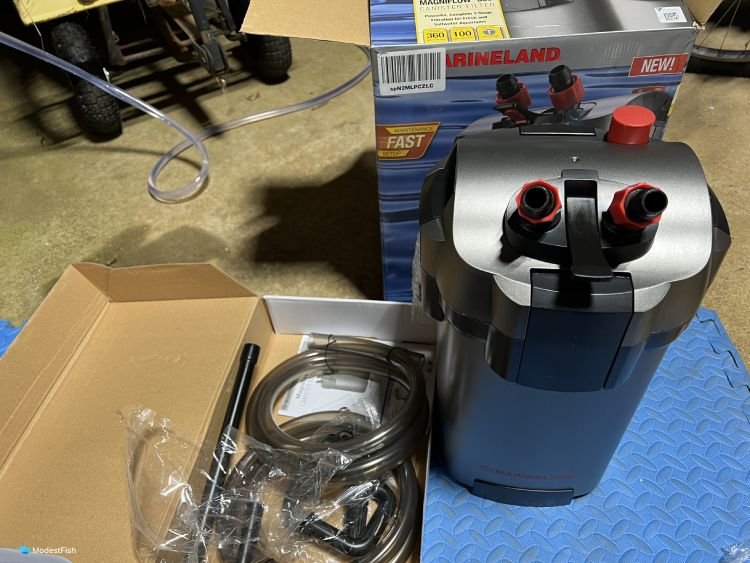
GPH: 249.5
Installation: it was harder to get this filter installed than any of the others. I was most displeased.
Setting up all the stuff on the inside of the filter is pretty straightforward. This filter utilizes stacking baskets, like most canister filters. You just have to rinse the media and place everything inside the body of the filter.
It’s all the outside pieces that are a serious pain.
The hoses for this filter are very stiff and difficult to route where you want them. I struggled to get the hoses attached to the intake and outflow pipes as well. I even tried to grease them a bit with petroleum jelly to make it easier and it was still a pain.
To top it off, you are supposed to use these small plastic hose clamps to secure the intake/outflow pipes in place. These narrow clamps are difficult and even painful to push closed with your fingers. I really did not like them at all.
I did, however, like the quick connect valve on this filter. Both of the hoses plug into a central valve that you can use to securely shut off the water flow. The valve can be popped off the motorhead with a lever, making maintenance easier.
But, it was a major wrestling match to get the hoses to unbend enough to attach to the valve.
The whole installation process was awkward and uncomfortable. I was not a fan.
Priming: it’s simple to get this filter primed. There is a large priming button on the top of the motorhead. You just push this a few times and water will start to flow into the canister.
The hose valve will retain the siphon for you, making priming after maintenance fairly effortless.
Maintenance: it’s very simple to perform maintenance on this filter.
It’s easy to pop the hoses off the top of the filter, which is nice.
I don’t like that you have to stick your arm down in the dirty poop water to pull out the baskets. I much prefer the handles on the Fluval filters that let me pull out all the baskets at once.
I also didn’t like how dirty the biomedia was due to this filter’s lack of mechanical filter media. I would add on some additional sponge material if I was going to run this filter long term.
Noise: this is the second noisiest filter that I tested. I got a reading of 55.1 decibels. This filter puts off a steady hum. It’s not loud, but since it’s a little over 3 times noisier than the Fluval FX6, it is a bit more noticeable than some of the other filters.
Best for: I would recommend this filter for 40-55 gallon (151-208 liter) tanks.
The Magniflow is a bit cheaper than the Fluval 407. So, it might be a good choice for someone who wants a lot of the same features as Fluval, but would like to shave some money off the cost.
Pros:
- Simple maintenance
- Competitive features at an economical price
- Great quick connect valve
Cons:
- Installation was a pain
- A bit noisier than some filters
- Not enough mechanical media

Last update on 2024-04-17 / Commissions Earned / Images from Amazon Product Advertising API
You can read my full in-depth review on the Marineland Magniflow canister filter here.
7. Polar Aurora
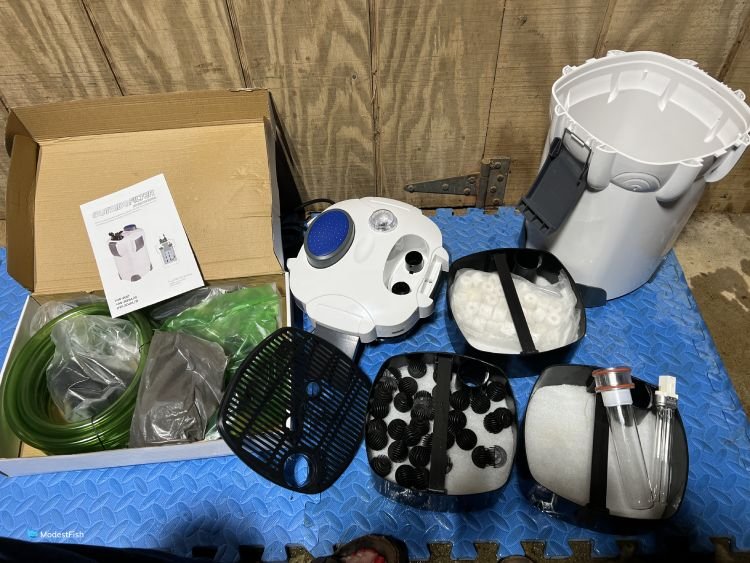
GPH: 196.94
Installation: installation was a bit of a pain for this filter as well.
The instructions were really lacking so I had to figure some things out by trial and error.
This filter includes a spray bar, which I like, but the curved outflow pipe does not allow you to put the bar very far down in the water. I wish it had an extender that would let you put it farther down in the tank.
I had a really hard time getting the bar far enough down so that it was under the water instead of spraying just above the surface.
I was really impressed that this filter comes with its own built-in UV sterilizer. This feature can help kill algae, viruses and bacteria in the water column and aid in water clarity.
Priming: getting this filter primed was difficult. I had a harder time priming this filter than any of the others.
It has a large priming button on top of the motorhead, but it was still very touchy trying to get the water flowing into the canister.
Once I finally did get the canister to fill, the filter still did not want to start up when I plugged it in.
I spent a good 20 minutes plugging/unplugging the canister, trying the button again, trying the plug again, before it finally started up.
I had a similar experience after doing maintenance. This filter is just touchier than the others.
Maintenance: it is very easy to clean this filter out during maintenance.
Once again, I did not like having to stick my arm down in the poop water to pull out the baskets.
Also, like some of the other filters, I thought the biomedia was overly dirty because of a lack of mechanical filter media.
But overall, it wasn’t hard or time consuming to break this filter down and clean out trapped wastes.
Noise: this was the noisiest filter that I tested. It was 4 times noisier than the Fluval FX6, putting out 56.4 decibels.
You can hear a buzzing sound from this filter, a bit sharper of a sound than the hum most of the others put off. It’s not super loud, but you will definitely hear it in a quiet room.
Best for: I think this filter is best for 30-50 gallon (113-190 liter) filters.
This is the most economical of all the filters that we tried out. It’s the best choice for someone who is more concerned about price than refinement.
Pros:
- Economical
- Comes with a built-in UV sterilizer
Cons:
- Instructions aren’t good
- Spray bar doesn’t reach down enough
- Loudest of all the filters
- Priming was difficult

Last update on 2024-04-18 / Commissions Earned / Images from Amazon Product Advertising API
You can read my full in-depth review on the Polar Aurora canister filter here.
Which Canister Filter Is Best For You?
Testing out all these filters was a huge project, but I’m so glad that I had the opportunity to do it.
It can be really hard to decide on which filter to buy, especially when they’re as expensive as a lot of canister filters are. User reviews can be inconsistent and it may be difficult to find all the information you want.
I tried to provide an overall impression of what it’s really like to set these up and use them in a home setting. That way, readers are armed with a whole lot of information before they lay their money on the line.
As usual, Fluval made the best showing. At this point, I’ve used an awful lot of Fluval products, and I have to say, their stuff really is worth the extra money.
Sometimes, you have to look at the cost of use for a product, instead of just the cost to purchase.
If things are unreliable and break down, it ends up being a lot more expensive to constantly replace cheap equipment than to just buy the good stuff in the first place.
But, I also understand what it’s like to be on a tight budget, in which case, the Aqueon Quietflow would probably be my first choice. It’s an excellent balance between price and nifty features.
However, if you’re looking for simplicity, the Eheim is a great choice for smaller tanks. It’s old school, straightforward and just plain gets the job done.
It doesn’t have all the bells and whistles, but it’s very effective at filtering out fish waste.
And I love the Oase Biomaster for tropical nano tanks. The built-in heater is a really nifty feature.
| Preview | Product | |
|---|---|---|

|
Fluval FX6 High Performance Aquarium Filter, Canister Filter for Aquariums up to 400 Gal. | Buy on Amazon |

|
Fluval 407 Perfomance Canister Filter - for Aquariums Up to 100 Gallons - Aquarium Canister Filter | Buy on Amazon |

|
EHEIM Classic 2215 External Canister Filter with Media for up to 92 US Gallons | Buy on Amazon |

|
OASE Indoor Aquatics Biomaster Thermo 250,Black | Buy on Amazon |

|
Aqueon QuietFlow Canister Filter 200 GPH, For Up to 55 Gallon Aquariums | Buy on Amazon |

|
Marineland Magniflow Canister Filter For aquariums, Easy Maintenance,Black | Buy on Amazon |

|
Polar Aurora Free Media 265GPH / 370GPH / 525GPH External Aquarium Filter with Builtin Pump Kit... | Buy on Amazon |
Last update on 2024-04-18 / Commissions Earned / Images from Amazon Product Advertising API

Hi Christopher,
Just checking if you have used/come across the SICCE EKO+ series – external canister filters before?
Are they as good?
Thank you for your comment. Sorry, I have not come across one before
Hi Christopher, just wanted to see what you thought of marineland magniflow filters? I was looking at the c360 model but read some reviews about leaky gaskets. I’m looking at a lower cost canister at a larger gph rated for 100 to 150 gallons. But I’m seeing a lot of people saying go with fluval or when, I don’t think I can afford that though. Any suggestions?
Hi Chris, hold tight, we are currently running and testing a bunch of canister filters right now. We’ll completely update this post over the next month or so once the tests and comparisons are finished 😀
This is a great post
I have the Marineland Magniflow 360. I disagree with you on noise level. Mine is extremely silent you wouldn’t know it was running. Also, as for media, it comes with plenty of media but you can always change it around to your liking. Choices are enless and this canister will hold it. I do however agree about the hoses. They’re impossible and overkill. Way too thick and stubborn. Flossing filters need to be changed often if you want crystal clear water. I change only the glossing filter weekly, the rest of the media monthly.
Hi, Leo. Thank you for sharing your experience. We decibel tested each canister filter and can only report on the score we got compared to the others. I wonder, is there anything you have the filter set on to help muffle the sound?